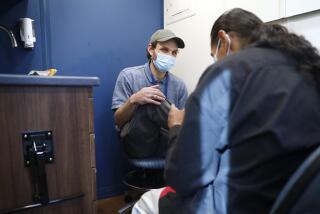Curing cancer isn’t always the goal. Sometimes you just want it to be a manageable chronic disease
- Share via
If you can’t beat ’em, manage ’em.
Millions of patients live by that rule every day — patients with chronic conditions that can’t be cured but can be kept under control with the right combination of medication, diet and lifestyle choices.
High blood pressure can be treated this way. So can diabetes. And increasingly, the same is true for cancer.
Sometimes patients and their doctors can manage cancer so successfully that it may seem to go away. Unfortunately, it doesn’t. And it could still go rogue at any time. But in the meantime, treating cancer like a chronic illness can often reduce both the financial cost and the physical risks of intensive treatment.
Consider prostate cancer. Traditionally, the recommended treatment has been radiation or removal of the prostate. Both approaches offer a good chance of a cure; regrettably, they also come with sizable risks, including impotence and incontinence.
But it’s now possible for many patients to avoid these risks, says Dr. Inderbir Gill, executive director of the USC Institute of Urology, because doctors have learned to distinguish between more and less dangerous prostate cancers. In many cases, patients with less dangerous varieties can safely opt for localized treatment, or even no treatment at all.
Not treating prostate cancer isn’t the same as doing nothing. Doctors keep very close tabs on the cancer using “active surveillance.” Then they take action if — and only if — it’s needed.
Prostate cancer isn’t the only type of cancer that is morphing into a chronic disease. In an article published in July in the New England Journal of Medicine, University of Michigan endocrinologist Megan Haymart and colleagues suggest that active surveillance may prove to be a good option for other cancers too, including low-risk differentiated thyroid cancer, ductal carcinoma in situ of the breast, and some skin cancers.
The authors note that active surveillance is not yet a perfected strategy. There is some debate about the best way to conduct it and make sure that patients keep up with it.
Besides, some patients — and physicians — are wary of this hands-off approach. Indeed, even when active surveillance is a viable option for patients with prostate cancer, about half of them still choose radiation or have their prostates removed.
In the case of prostate cancer, treating it as a chronic illness can be seen as a lower-cost, lower-risk alternative to a cure. But with some other types of cancer, treating it as a chronic illness is the only game in town.
For example, chronic myelogenous leukemia used to be fatal in almost every case, says Dr. J. Leonard Lichtenfeld, deputy chief medical officer of the American Cancer Society. Now, though, patients can live nearly normal life spans.
The difference? The introduction in 2001 of Gleevec (imatinib mesylate), a targeted therapy drug that attacks cancer cells but leaves other cells alone.
Gleevec doesn’t cure the leukemia, Lichtenfeld says. But as long as patients keep taking it, they can keep their cancer at bay. Many would consider that a victory. “It’s dramatically changed the course of the disease,” he says.
Unfortunately, the number of cancer types that can be turned into chronic diseases is still fairly small, but that will change, says Dr. John Glaspy, an oncologist at the Jonsson Comprehensive Cancer Center at UCLA. “We understand cancer much better than ever before, and with knowledge comes the power to intervene.”
In the 1950s, iron lungs were the order of the day for polio patients, Glaspy recalls, because they were the best treatment science had to offer. But they were expensive and unpleasant, and they were neither a prevention nor a cure. So researchers kept working — and along came vaccines from Jonas Salk and Albert Sabin.
“We’re gaining on cancer,” Glaspy says. “We just have to keep up the chase. We’re in the iron lung stage right now. We can’t afford to stop there. If we fail, it won’t be because cancer beat us. It will be because we lost faith in ourselves and our brains.”
MORE IN HEALTHY LIVING
With cancer, it’s not necessarily where it starts but how it starts
When it comes to cancer, here’s what you should sweat and here’s what you shouldn’t
Rethinking cancer, from the basics to the breakthroughs






